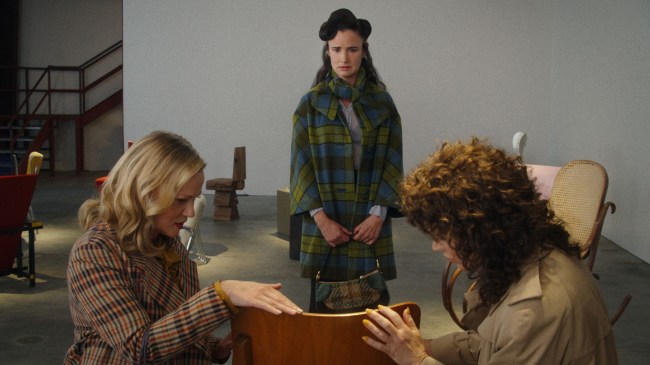“Who values Camille as much as a chair? She has never been able to sit there quietly and still be loved?”
These words, spoken by an unseen narrator (Melanie Lynskey) at the beginning of “By design” synthesize the premise of Amanda Kramers latest work, a gore-free installment of body horror which seeks to explore female objectification in as literal terms as possible. Using abstract dance and painful silences to illustrate the contrasting experiences of a woman and a lifeless chair changing bodies, film unfolds like a brooding nightmare told through the distinct gaze that endeared Kramer’s films “Please Baby Please” and “Ladyworld” unforgettable. The film often feels as impossible to definitively grasp as the coveted furniture it follows — but whether that’s a feature or a bug is in the eye of the beholder.
When we meet Camille (Juliette Lewis), she is trapped in a life of soul-crushing monotony that seems benign from the outside. Craving some sort of intellectual stimulation, she spends her days going to boring lunches with her “friends” Lisa (Samantha Lewis) and Irene (Robin Tunney), who speak exclusively in pleasantries that drip with passive aggression. Kramer writes and shoots his conversations with a deliberate stiffness, stylizing the sequences of female intrasexual competition to the point where you can’t possibly be fooled into believing the kind words that leave their mouths. Each lunch filled with humble bragging is followed by an afternoon shopping spree, where the three women admire furniture they’re quick to point out the others could never afford.
One such trip becomes a life-changing event when Camille sees a chair that changes her entire world view. Whether she is truly moved by the beauty of its design or just looking for an excuse to blow up her own routine is irrelevant. She decides she simply has to have it. She spends the evening sorting out her meager finances and talking herself into making a purchase she can’t quite afford, turning up the moment the shop opens the next day to buy it – only to find that a mysterious other customer already beat her to it. In a moment of desperation, she wishes she could become the chair, thinking that something so beautiful must have a more comfortable life than she does.
She gets her wish, and soon she is transported to an eccentric musician named Olivier (Mamoudou Athie). A pianist who makes a living playing private parties for groups of six or less in strange rooms that feel ripped from a Lynchian nightmare, he’s never been one for possessions. His bachelor pad feels ripped straight from /r/malelivingspace, with little more than a keyboard, mattress and a pair of dumbbells adorning the floor. Finally, this chair feels like something beautiful he can really own. With a world of collectors trying to get it from him, his minimalism evaporates as the protection of his worldly attachment to it becomes his sole focus.
The rest of the film unfolds in increasingly non-verbal terms, as the chair containing Camille’s soul has no mouth to express her thoughts and her body with the mind of a chair has no such thoughts to express. Kramer relies heavily on interpretive dance and classical music to convey emotion, creating an immersive world that is beautiful on the surface but lacks any authentic warmth. “By Design” becomes an exploration of how Camille and the chair’s lives change and how they stay the same.
Despite Camille being reduced to an inanimate object who can do little more than sit with a blank look in her eyes, her conversation with her overbearing mother doesn’t change much. She could barely get a word in between her mother’s stories and complaints before her mind was like a chair – and if anything, the matriarch is just grateful to have even fewer interruptions to endure. Her conversations with Lisa and Irene are equally banal. While the two friends at least notice that she has changed, they turn the occasion into an opportunity to compete to see who can appear to do more to help her without actually doing anything at all.
Kramer deliberately chooses the broadest metaphors possible, resulting in a film more interested in using a hammer to bluntly shape the contours of the female experience than painting its finest details with a subtle brush. But its biggest ideas — like how society doesn’t seem to care when a woman completely loses her ability to speak; or the contradiction between a woman longing for intellectual stimulation yet yielding to desire and obsessed for her looks alone—are certainly worthy of exploration in her capable hands. Visually unmistakable and fearlessly abstract, “By Design” stands as a key entry in an increasingly important filmography. It won’t be for everyone, but it’s by design.
Grade: B
“By Design” premiered in 2025 Sundance Film festival. It is currently seeking distribution in the United States.
Want to keep you updated on IndieWire’s film reviews and critical thoughts? Subscribe here to our newly launched newsletter, In Review by David Ehrlich, where our chief film critic and chief reviews editor gathers the best new reviews and streaming picks along with some exclusive musings—all available only to subscribers.







